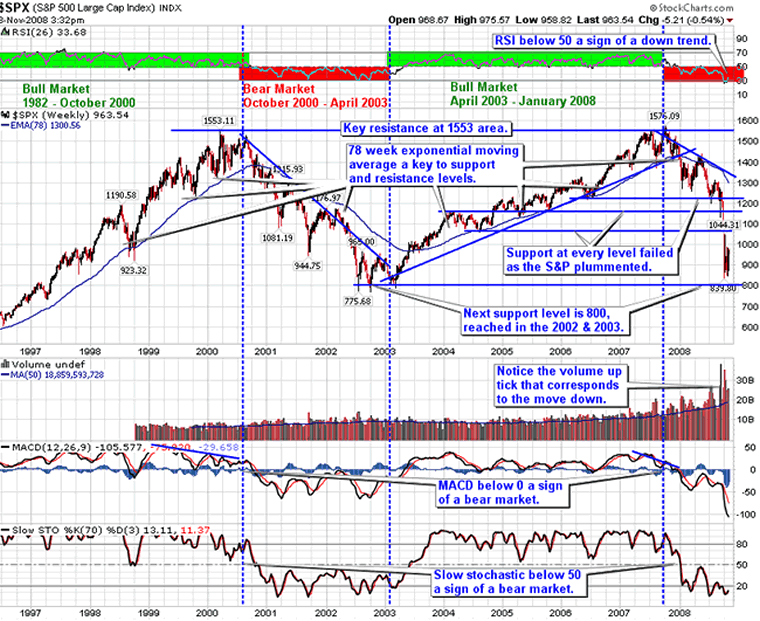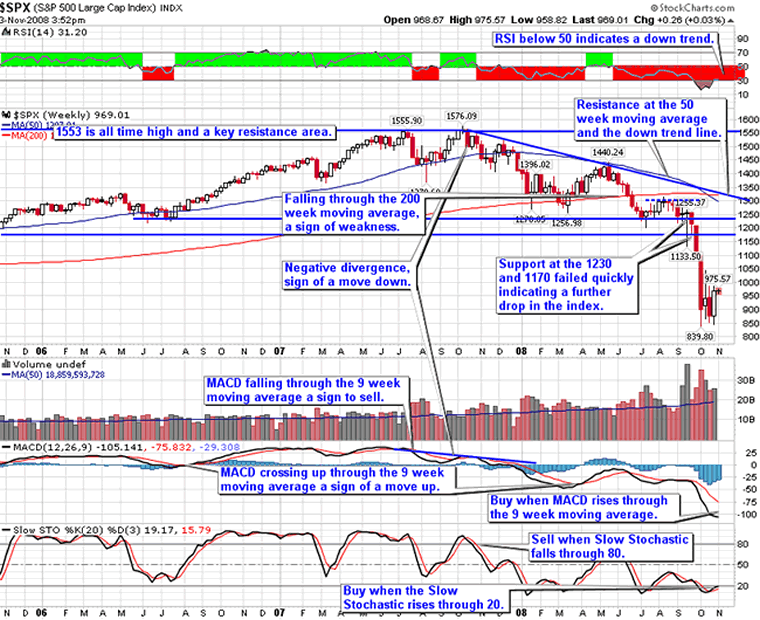Stock Market Trends November 2008 Forming a Base
Stock-Markets / Stocks Bear Market Nov 07, 2008 - 06:04 AM GMTBy: Hans_Wagner
 Following the trend is a proven way to beat the market and grow your stock portfolio. Learn to invest using basic technical analysis that provides the tools to identify and follow the trends of the market using the S&P 500.
Following the trend is a proven way to beat the market and grow your stock portfolio. Learn to invest using basic technical analysis that provides the tools to identify and follow the trends of the market using the S&P 500.
It is best to begin with the big picture in mind and then work our way down to weekly and then daily views of the charts. You will notice that the chart and the value of the indicators change as we move from a monthly to a weekly and then a daily chart. This is a normal part of the technical analysis.
Let's start with the long term view of the S&P 500. The Relative Strength Index (RSI) is a good indicator of the cyclical bull and bear markets. In addition, the 78-week Exponential Moving Average (EMA) acts as support in a bull market and resistance in a bear market.
In January, we fell into a bear market as the RSI dropped below 50. The index fell through the rising trend line and the 78-week exponential moving average and MACD crossed below zero. This is consistent with the fundamentals of a weakening economy, and a recession. It is best to remain nimble during times like this.
In the turmoil of September and October, the S&P 500 fell through the support levels, which were indicators of further weakness. Now the index testing the 800 area, the low reached in 2002 and 2003.
The MACD is trending down, though it is at a low point where it normally turns up. The Slow Stochastic is trying to turn up through 20, an early buy signal.
The 78-week exponential moving average and the bear market down trend remain as key resistance for the bear market.

The weekly S&P 500 shows more closely the transition from a bull to a bear market. So far, the descending trend line and the 50-week moving average are the primary resistance for this bear market.
In late September and October support at 1230 and 1170 failed, indicating further weakness was ahead. The index is now creating new three-year lows where it could be forming a new support level at 850.
RSI below 50 indicates a downtrend. MACD is at a low point and is poised to turn up. When it rises through the 9-week moving average, we will have a buy sign. Slow Stochastic rose through 20 and then fell back. It once again is trying to rise through 20, which is an early buy sign.
Long term the trend is still down, but we are likely to see consolidation at this level and possibly a rally up to resistance at the 1200 area.

In the daily S&P 500 chart below a horizontal channel is forming with support at 850 and resistance at 1,000. This is a good sign that the market is forming a base from which it can rally.
However, it can also fall further.
RSI is below 50 indicating a downtrend, though it is close to breaking up through 50. The MACD rose up through the 9-day moving average, a buy sign. The Slow Stochastic signaled a buy when it moved up through 20 once again. The indicators are giving a buy sign, indicating a rally is most likely.
Look for a break through the 1,000 level as a sign the market will go higher. If that happens it would indicate a year end rally is underway that often takes place in November and even December. We could also see a pull back from the 1,000 level before making a push up through this resistance level. If this happens, use the dip in price as a buying opportunity.
Should we get a move up, look for resistance at the lower descending trend line and the 50 simple moving average. If the rally pushes through this level, the 200 simple and exponential moving averages will provide significant resistance. The upper descending trend line will also provide strong resistance.
In bear markets, it is best to be nimble and/or use risk protection such as trailing stops, protective put options and even covered call options. On a sign the market is reaching unable to penetrate resistance, you might consider using the short and ultra short ETFs.

Given this perspective, it is important to have your portfolio positioned for a short-term rally and a long-term bear market. This means investors should assess their long positions to see if they are ready for a multi week to multi month rally. Then once the rally is over, they need to be ready to short the market, as we will likely see a test of the recent lows.
When the market falls during a bear market, you should either be in cash or be short. The short and ultra short ETFs are good ways to short the market without having to depend on selecting specific stocks.
While it is tempting to buy when the market falls, it is a better strategy to be sure the market has formed a base. Most likely the prices of many companies will be even lower. Just keep in mind, Warren Buffett's first rule of investing is to not loose money. Patience is key, when markets are moving down.
To learn to invest by analyzing market trends using technical analysis I suggest reading:
Stan Weinstein's Secrets For Profiting in Bull and Bear Markets ![]() is one of the best books on "reading the market". It is an early book on technical analysis, but still one of the best, especially for people new to technical analysis.
is one of the best books on "reading the market". It is an early book on technical analysis, but still one of the best, especially for people new to technical analysis.
By Hans Wagner
tradingonlinemarkets.com
My Name is Hans Wagner and as a long time investor, I was fortunate to retire at 55. I believe you can employ simple investment principles to find and evaluate companies before committing one's hard earned money. Recently, after my children and their friends graduated from college, I found my self helping them to learn about the stock market and investing in stocks. As a result I created a website that provides a growing set of information on many investing topics along with sample portfolios that consistently beat the market at http://www.tradingonlinemarkets.com/
Copyright © 2008 Hans Wagner
Hans Wagner Archive |
© 2005-2022 http://www.MarketOracle.co.uk - The Market Oracle is a FREE Daily Financial Markets Analysis & Forecasting online publication.



